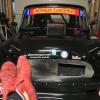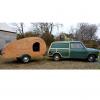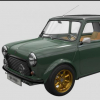
Boot Hinges Binding.

Best Answer Rubbershorts , 29 March 2025 - 09:11 AM
As I was keen to try get a run in the car this weekend, and not having access to the other helpful methods offered up by everyone, I just snipped off the edge of the hinges with the grinder. Annoyingly it was still binding. The bottom edge of the lid was fouling on the hinge panel. Steve Sonscar had noticed that the screw heads looked a little large, and could potentially be altering the angle of the hinge. These are stainless ones I bought separately from the hinges to reduce the chance of rusting, so gave the originals a try. It turns out they are too big. The diameter is larger than the standard screws that were supplied with the hinges, and this was taking up any adjustment that might be available when fitting the hinges. With the smaller diameter fitted I could pull the lid upwards away from the hinge panel and when nipped up the boot shuts as it did previously. Thanks for all the input guys👍 Daz.
Go to the full post 
#1

Posted 27 March 2025 - 10:03 PM
#2

Posted 28 March 2025 - 05:02 AM
#3

Posted 28 March 2025 - 06:09 AM
#4

Posted 28 March 2025 - 07:01 AM
Ok, you should use new gaskets each time the hinges are replaced. You do have them on the correct sides?
#5

Posted 28 March 2025 - 08:52 AM
It may be that the sill panel is at a steeper angle than it should be. If so, the old hinges possibly allowed more slack due to wear on the hinge-pins.
If it was mine, I'd try 3D-printing some wedge-shape gaskets (in black flex material) to go under the bottom parts, to tilt them forwards slightly.
#6

Posted 28 March 2025 - 10:00 AM
Ok, you should use new gaskets each time the hinges are replaced. You do have them on the correct sides?
New gaskets and swapped them around to check I had them right.
#7

Posted 28 March 2025 - 10:02 AM
It may be that the sill panel is at a steeper angle than it should be. If so, the old hinges possibly allowed more slack due to wear on the hinge-pins.
If it was mine, I'd try 3D-printing some wedge-shape gaskets (in black flex material) to go under the bottom parts, to tilt them forwards slightly.
I think you're right about the wear on the old ones. The printing of a wedge is a brilliant idea. If only I had a 3d printer.
#8

Posted 28 March 2025 - 10:48 AM
It looks like it wouldn't take much of a touch with a file to create some clearance where they kiss.
#9

Posted 28 March 2025 - 10:52 AM
I'm not sure I'd trust a 3d print, obviously though that depends what filament you're using.. I've only really played with PLA and Im sure that would be too brittle over time, it'd end up cracking with repeated use I think. maybe ABS or something might work ok
I would rather machine a piece from steel or alloy or something I think (or get someone to do that for me)
or as Ethel says, tweak the hinge slightly till it moves far enough
I think i'm going to have to do something similar on mine, where I replaced the bottom edge, left/right the door lines up well, but opening and closing I'm not sure, possibly just because I haven't got he rubber seal on it yet. probably some fettling required
Edited by stuart bowes, 28 March 2025 - 10:54 AM.
#10

Posted 28 March 2025 - 11:12 AM
#11

Posted 28 March 2025 - 11:43 AM
just quickly acknowledging that Alpder did specify a flexible material..
I really should play around with some other filaments really just never got around to it
#12

Posted 28 March 2025 - 12:52 PM
I really should play around with some other filaments really just never got around to it
For rigid things, PET is the business, but only if you have a heated bed. I've made external light brackets for my teardrop trailers from it. Prusa's own PET-G is expensive but far better than generics from Amazon etc. Zero pong, loads of colours including translucent options, and has a lovely finish. Needs £special£ glue though, and can't be solvent-smoothed like ABS can, either.
ABS is horrible to use - very smelly. But can be glued easily. PLA, as you say, is veg-based and not great outdoors long-term. I haven't used either since the very early days on a home-made Mendel (remember those shonky things... how we suffered with glass beds and endlessly replacing the Kapton tape. Got it so easy nowadays.)
Flexifill 98A is a really useful one to keep on the shelf: slightly flexible, doesn't creep or go brittle, and doesn't seem to suffer outdoors - I've used it to make gaskets to go under my non-standard door mirrors because the mirror base is flat but the door isn't, for flexible stalks to hold reflectors on trailers, and bespoke covers for + terminals on batteries.
#13

Posted 28 March 2025 - 01:43 PM
that's really helpful cheers, will do a bit of googling/shopping at some point I think
I do have a heated bed yeah, what sort of temps are we talking (apologies for derailment, just this one last question lol)
#14

Posted 28 March 2025 - 02:27 PM
This table is a good guide: https://help.prusa3d...-material-guide . Most of the exotic materials (ones that require heated enclosure and/or require hardened nozzle and/or require special types of bed surface) are too much faff or won't print reliably. PLA, PET-G, ABS, and Flex (Flexifil 98A etc) are the mainstays for most hobbyists. Prusa's smooth and textured PEI bed surfaces are superb for these materials and other printer beds may struggle to bond (or to de-bond after printing) and might need different bed temps. If you need more, do start a thread in 'Chit-Chat', link it in this thread, and we can continue there.
#15

Posted 28 March 2025 - 05:30 PM
1 user(s) are reading this topic
0 members, 1 guests, 0 anonymous users




















